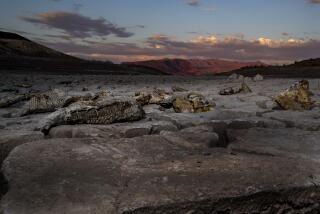Ancient Trees Reflect Century-Long Droughts : Environment: Analysis of stumps’ rings shows that dry spells can last far longer than the state has estimated, expert says.
- Share via
A study of the stumps of ancient trees that once grew from stream beds and lake bottoms in the Sierra Nevada has turned up new evidence that droughts in California can last 100 years or more, far longer than the state’s official estimates.
In this week’s issue of the British journal Nature, a Cal State Hayward professor writes that submerged stumps in Mono Lake, Tenaya Lake in Yosemite National Park, the West Walker River in the northern Sierra and Osgood Swamp near Lake Tahoe are relics of trees that grew on land that was uncovered when droughts reduced water levels by up to 60 feet.
The cottonwoods and Jeffrey pines drowned when the drought ended and high water returned, according to Scott Stine, a professor of physical geology. He attributes the droughts to extended periods of naturally caused global warming which, if they recurred, could have disastrous effects.
“The message for California is that we are subject to droughts far more severe and persistent than we have ever realized,” Stine said in an interview this week. “While we can’t predict when such droughts will occur, we would be fools to think that they won’t.
If they recur, Stine said, “the current urban and agricultural infrastructure could not be maintained. It would bring California to its knees.”
Studies by the California Department of Water Resources have concluded that the worst droughts have not lasted much longer than the state’s recent seven-year dry spell. Officials base that assertion on 90 years of recorded weather information and tree ring data from 450-year-old trees.
However, state officials acknowledged this week that at least one other study, published in 1922, discusses a drought in California that lasted more than a century. Bill Mork, a state hydrologist, said the department never relied on the 1922 book because “we don’t know where they got the data.”
In fact, Stine’s work reinforces a growing body of scholarly opinion that California has experienced dry spells of biblical proportions. Two ongoing research projects, one looking at tree rings in the Sierra near Mt. Whitney and another focusing on core samples from San Francisco Bay, lend credence to the theory of prolonged drought.
Stine’s research on the stumps of ancient trees relied on radiocarbon dating to determine when the trees had been drowned--and, thus, when the droughts had ended. By counting rings in the interior of each stump, Stine calculated the life span of the trees and thus the length of the droughts.
He concludes that two long droughts--one from about AD 900 to about AD 1112 and a later one from about 1210 to 1350--were interrupted by an abnormally wet period.
Stine’s research did not dwell on the cause of the droughts, but he wrote that his findings support theories that dramatic climate fluctuations for several hundred years leading up to the 14th Century had a profound, worldwide effect. In northern Europe, the period known as the Medieval Warm Epoch was a time of agricultural abundance that helped European civilization expand greatly.
Stine attributes the long warming trend to a natural phenomenon: a change in the position of the jet stream or storm track--the boundary between cool, polar air and warm, subtropical air along which storms occur. “The storm track simply moved northward during the two periods,” he said.
Stine’s work is one of at least three independent research projects that come to similar conclusions about centuries-old weather patterns in California.
Tree ring studies on ancient pines and junipers near Mt. Whitney by the University of Arizona’s tree ring research laboratory have also found indications of prolonged drought, occurring about the same time as Stine estimates--between 900 and 1300.
“I was shocked at the length of the droughts I was finding,” said Lisa Graumlich, a professor of dendrochronology--the study of tree rings--at the University of Arizona who began performing research in the Sierra eight years ago.
“What this means is that when we plan on water resource availability based on the 20th-Century record, we are probably making some critical errors since the longest-recorded drought during the 1920s and ‘30s lasted less than 10 years,” Graumlich said. “The 20th Century is really quite anomalous. It appears to be the second-wettest period in the 1,000-year record.”
The third study, looking at 5,000-year-old mollusks from the bottom of San Francisco Bay, also bolsters the case for the hundred-year drought, according to Lynn Ingram, a doctoral fellow in geology and geophysics at UC Berkeley.
More to Read
Sign up for Essential California
The most important California stories and recommendations in your inbox every morning.
You may occasionally receive promotional content from the Los Angeles Times.













